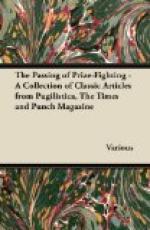NO. 4.
NATURAL HISTORY.
Definition.—The history of “naturals”—which chiefly include the human species—and of “simples” (herbs), occupies the branch of science we are about to enlighten our readers upon. It treats, in fact, of animated nature; while physical history—instead of being the history of Apothecaries’ Hall, as many suppose—deals exclusively with inanimate matter.
Of genus, species, and orders.—If, in the vegetable world, we commence with the buttercup, and trace all the various kinds and sizes of plants that exist, up to the pine (Norwegian), and down again to the hautboy (Cormack’s Princesses); if, among the lower animals, we begin with a gnat and go up to an elephant, or select from the human species a Lord John Russell, and place him beside a professor Whewell, we shall see that nature provides an endless variety of all sorts of everything. Now, to render a knowledge of everything in natural history as difficult of acquirement as possible to everybody, the scientific world divides nature into the above-mentioned classes, to which Latin names are given. For instance, it would be vulgarly ridiculous to call a “cat” by its right name; and when one says “cat,” a dogmatic naturalist is justified in thinking one means a lion or tiger, both these belonging to the category of “cats;” hence, a “cat” is denominated, for shortness, felis AEgyptiacus; an ass is turned into a horse, by being an equus; a woman into a man, for with him she is equally homo.
Of this last species it is our purpose exclusively to treat. The variety of it we commence with is,
THE BARBER (homo emollientissimus.—TRUEFIT).
Physical structure and peculiarities.—The most singular peculiarity of the barber is, that although, in his avocations, he always is what is termed a “strapper,” yet his stature is usually short. His tongue, however, makes up for this deficiency, being remarkably long,—a beautiful provision of nature; for while he is seldom called upon to use his legs with rapidity, his lingual organ is always obliged to be on the “run.” His eyes are keen, and his wits sharp; his mouth is tinged with humour, and his hair—particularly when threatening to be gray—with poudre unique. Manner, prepossessing; crop, close; fingers, dirty; toes, turned out. He seldom indulges in whiskers, for his business is to shave.
1. Habits, reproduction, and food.—A singular uniformity of habits is observable amongst barbers. They all live in shops curiously adorned with play-bills and pomatum-pots, and use the same formulary of conversation to every new customer. All are politicians on both sides of every subject; and if there happen to be three sides to a question, they take a triangular view of it.
2. Reproduction.—Some men are born barbers, others have barberism thrust upon them. The first class are brought forth in but small numbers, for shavers seldom pair. The second take to the razor from disappointment in trade or in love. This is evident, from the habits of the animal when alone, at which period, if observed, a deep, mysterious, melo-dramatic gloom will be seen to overspread his countenance. He is essentially a social being; company is as necessary to his existence as beards.




